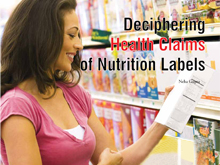Health Topics
-
Healthy Living
-
|
|
April 2011
|
| Deciphering Health Claims of Nutrition Labels |
| Neha Gupta |
| |
 |
Dozens of food products are misleading as they provide false information to attract their health conscious customers who are under peer pressure to buy healthy food stuff. This necessitates evaluation of health claims of nutrition labels. |
‘Act’ual Matters
According to Prevention of Food Adulteration Act (PFA), it is mandatory for food packagers to declare the nutrition content on their product. Nutrition labels help us to know whether we are eating a healthy or balanced diet. Some of the elements that nutrition labels should include are: fat, total fat, saturated fat, trans fat, cholesterol, sodium, total carbohydrate, dietary fibre, sugar, protein, vitamins, minerals, serving size and calorie content.
Labels Demystified
Obviously these names can be confusing. So given below are descriptions of some of these:
- Saturated fat: Saturated fat can increase the risk of heart disease and high cholesterol. The average adult should consume no more than 20 grams of saturated fat per day.
- Trans fat: Trans fat also increases your risk of heart disease. Ideally, you should get 0 grams of trans fat per day. When you read a nutrition label, remember that companies are allowed to list the amount of trans fat as “0 grams†if it contains less than 0.5 grams of trans fat per serving. This means that your food can contain some trans fat even if the nutrition label says “0 grams†per serving! Always check the ingredient list for trans fat, which may be listed as “hydrogenated vegetable oil†or “partially hydrogenated vegetable oil.†Trans fat is usually found in commercially prepared baked goods, fried foods, snack foods and margarine.
- Cholesterol: You should eat less than 300 milligrams of cholesterol per day (less than 200 milligrams per day if you have heart disease).
- Fibre: It can help lower your risk of diabetes and heart disease. A food is considered high in fibre if it contains five grams of fibre or more per serving. Men 50 years of age and younger should get at least 40 grams of fibre per day, while women 50 years of age and younger should consume at least 25- 30 grams of fibre per day. Fibre is found in foods such as fruit, vegetables and whole grains. Look for the words “whole grain†on the package and ingredient list for fibre content.
- Vitamins and Minerals: Often, nutrition labels list vitamin A, vitamin C, calcium and iron. You should try to get more of these nutrients in your daily diet, as well as other vitamins and minerals that are not listed on the label.
Beware of Health claims
It is important to know more about some of these claims:
- Brown bread: Brown bread does not mean that it is made out of wheat flour. It can be normal white bread, in which brown colour has been added for the appearance. So we have to look at the ingredients of the product. If whole wheat flour is mentioned as main ingredient of brown bread, it implies the product is made of wheat.
- Cholesterol: Make sure you buy vegetable oils as they do not contain cholesterol. Cholesterol is present in majority of animal products which include desi ghee, butter.
- Cholesterol-free butter: If any label of butter claims that it has no cholesterol, then you need to be careful. That product is created through the process of hydrogenation, which may not have the cholesterol but trans fat, which is equally harmful.
- Nutritious packaged juice: Only fresh fruit have vitamins and minerals in them. During processing many of the vitamins get destroyed. Fruit juices are high in calories, so for low calorie juices, check if they are sugar free.
- Salt: It is an additive and preservative. In some of the processed foods, it is used as preservative. If a person requires food with low sodium content, he/she should check the preservative content of the food stuff.
- Calorie free sugar (Sugar free): This kind of sugar is basically an artificial chemical (which gives it the sweet taste) on which long term studies have not been done. So there is no recommendation on how much should be consumed.
Almost every company claims that their food is nutritious. But don’t get swayed by such claims. Remember it is their marketing strategy. Check how the product describes its nutrition content, whether it explains the content in detail. For example, if you find that the label says “wheat flour fortified with Vitamin A’, then you can be a lot more sure of the product than that which says ‘made of wheat flour’ or ‘contains Vitamin A’. |
Neha Gupta is Lifestyle Counsellor, Apollo Life, New Delhi
|
|
|